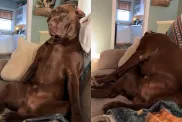by Michael Mountain
Founder, Best Friends Animal Society and The Stubby Dog Project
About 32,000 years ago, a tall man and a young boy crawled through a small space in the ground in southern France, worked their way down a steep shaft, and stood up in a huge underground cavern.
There, along with others of their clan, and using flickering torches among the stalactites, they painted the first known great works of art: representations of animals they knew in their daily lives – mammoths, bears, a lion, a rhinoceros, a 30-foot-long frieze of animals.
They were doing this 20,000 years before civilization as we know it got underway with agriculture, the first towns, a new social order, and the kind of artwork that’s been found in other, better-known caves like Lascaux.
Seven years ago, the cave was rediscovered. Known as Chauvet, it was quickly closed to the public to preserve its delicate atmosphere. But last year, film-maker Werner Herzog got permission to go in with his cameras and with three other people for a total of 24 hours. The result is his new movie, Cave of Forgotten Dreams, which opens in a few cities this weekend.
I have only seen some clips from the movie, but it is clearly an awesome experience. And “awe” is a word that describes not only what most of us will feel when we see the movie, but also what the original artists, our ancestors, must have felt about the world around them. The cave at Chauvet became their sanctuary, where they could commune in a more intimate way with the animals, and where they could express their own sense of wonder and vulnerability.
Those people were indeed vulnerable. Back then, humans were little more than a prey species, far outnumbered by bears, big cats, and other animals.
But in the flickering darkness of Chauvet, as Herzog describes it, we started relating to those animals in a new way.
“What you are witnessing,” he says, “is the origin of the modern human soul and the beginning of figurative representation.”
To see these paintings, then, is to see our own birth as a people, producing art that’s not very different from what we create today.
Still, their world was indeed a different one. It was not a human world; it was an animal world. We did not see ourselves as its masters, nor ever imagined such a thing.
Remarkably, on the cave walls of Chauvet, there are also no depictions of hunting. Back then, we were not even imagining ourselves as having that kind of power over the animals. We were simply living among them, and trying to understand ourselves through them.
If the cave at Chauvet shows us our birth as a people, what can we say about ourselves today?
Many of the animals our ancestors knew, like the mammoth, are gone altogether. Others, like the lions, are fast disappearing. We no longer view them with awe and wonder; instead, they have become little more than resources – shrink-wrapped food items, spare body parts, objects on which we try out new cosmetics and cleaning products. And to give our children an “experience” of them, we put them behind bars.
Our whole sense of time is different, too. Since they felt connected to everything in nature, their world was alive in an eternal present. In our world today, by comparison, there is barely even a fleeting present. Rather, we are consumed by our regrets over yesterday and our hopes and fears for tomorrow.
“We are locked in history; they were not,” Herzog says.
Their time was the infancy of human civilization; ours is its decline. They were discovering their soul; we are losing ours.
But if we can’t go back to that early time, any more than we can return to our own childhood, we can still recapture something of that original connection with the animals.
To do that, we need to respect them as fellow travelers on a planet that’s their home as well as our own. We need to appreciate that we are still, in fact, as vulnerable as we ever were – a species like any other, gifted in many ways, always at the mercy of forces far greater than ourselves, and simply playing our own small part in the unfolding of life.
Like a message from our own childhood, the cave at Chauvet can help us make that connection. Its art tells us that in many ways we are still the same people we ever were. And through a great movie, made possible by the best of modern technology, we can reach back to the very earliest of great art and gain a stronger sense of our own nature.
And just as our ancestors felt their way into and out of a darkened cave, we may emerge from a darkened theater with a similar sense of awe and wonder, of intimacy with the animals, and with a renewed connection with our own soul – the same one that our ancestors were discovering 32,000 years ago at Chauvet.
This article first appeared here on zoenature.org.
Michael Mountain is one of the founders of Best Friends Animal Society, the nation’s largest animal sanctuary and one of the pioneers of the no-kill movement for homeless pets. As president of Best Friends and editor of Best Friends magazine, he helped to build grassroots adoption and spay/neuter programs all over the country before stepping down in 2008. He currently is the editor and co-founder of Zoe— a new online magazine for people who care about animals, nature and the environment — and the co-founder of StubbyDog, which is working to change public perceptions of Pit Bulls.









